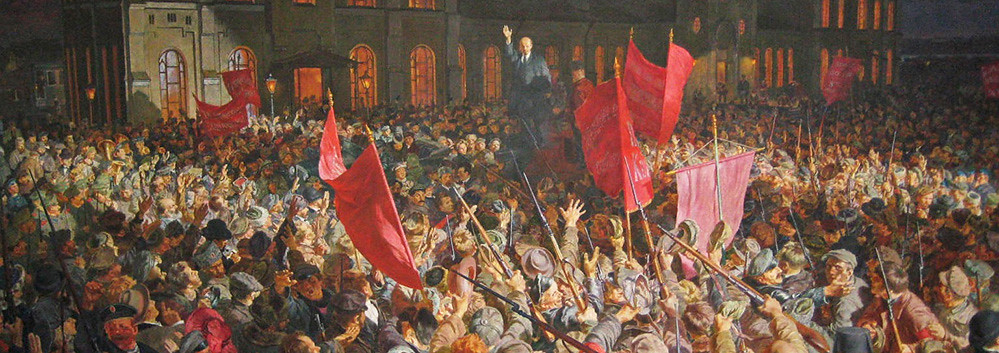The 'Red October' of 1917: a coup d'état against a democracy, not against tsarism
Today marks the 105th anniversary of the coup that gave rise to the first communist dictatorship, established in Russia under the command of the tyrant Vladimir Lenin.
There is a very common confusion about this coup, commonly known as the "Bolshevik Revolution" and "Red October". This confusion has often been inspired by the communists themselves, and is based on the belief that the Bolshevik coup d'état of November 7, 1917 (October 25, in the Julian calendar that was used at the time in Russia) was against tsarism. Historical facts flatly refute this idea.
Tsardom was overthrown by the Russian Revolution in March 1917
This confusion is very common because, so to speak, in Russia there were two different revolutions in 1917. It was the Russian Revolution of March 8, 1917 that overthrew Tsar Nicholas II, who abdicated one more week late, on March 15. A provisional government was then established in Russia, headed by Aleksandr Kerensky, a member of the Social-Revolutionary Party (a social-democratic formation) and made up mostly of liberals . Let us remember that Russia was then at war with Germany and the Austro-Hungarian Empire. The provisional government continued the war, despite the difficulties that this caused due to the great political instability in the country.
The government of the Russian Republic called elections for November 25, 1917
At the initiative of that provisional government, on September 1, 1917 the Russian Republic was proclaimed, putting an end to 370 years of tsarism. The new republic faced numerous challenges. The former territory of the Russian Empire was in decomposition, with Poles, Finns, Ukrainians, Lithuanians, Latvians and Estonians laying the foundations for their independence, and with the Bolsheviks controlling part of Russian territory. On September 9, 1917, the provisional government suffered a first coup, led by General Lavr Kornilov and supported by right-wing forces. This first coup failed, but it served to weaken the Kerensky government and give more strength to the Bolsheviks, the most radical communist faction of the Russian Social Democratic Labor Party (RSDLP). A led faction by Lenin.
The Bolsheviks seized power by force on November 7, 1917
Even before Kornilov's coup, the provisional government had called elections to the Russian Constituent Assembly, in which the new government should be elected. Elections were set for November 25. However, on the night of November 7, 1917, the Bolsheviks, led by Lenin, staged a coup, arresting members of the provisional government (although Kerensky managed to elude capture). As soon as they took power, the first thing the Bolsheviks did was pass a press censorship law, in order to silence their rivals. The Bolshevik coup caused the start of a civil war in Russia.
The Bolsheviks lost the elections despite their repressive campaign
Despite the coup, the Bolsheviks maintained the call for elections on November 25, perhaps hoping that they would win them thanks to the repressive wave they had launched. But it was not like that. The elections gave a resounding victory to the social-revolutionaries, with 41% of the votes, with the Bolsheviks obtaining 23.5%. Indifferent to the result, the Bolsheviks remained in power and continued their repressive campaign, outlawing the Constitutional Democratic Party, which had obtained good results in Moscow and Petrograd. Russia had ceased to be a democracy.
Lenin dissolved the Constituent Assembly after its first meeting
The clearest proof of the beginning of Lenin's dictatorship came in December, when the Bolshevik government founded its brutal political police: the Cheka, which became famous for resorting to the most savage methods of torture. Then began the so-called red terror, a communist dictatorship in which for six years more than a million people were murdered for political reasons. The Constituent Assembly elected in the elections of November 25, 1917 only met once, on January 5, 1918. In a confirmation of the kind of regime that had been established in Russia, on January 19, 1918, the government of Lenin dissolved the Constituent Assembly.
The communists continue to celebrate that undemocratic coup d'état
To this day, and despite the facts that we have just reviewed, the communists continue to celebrate that anti-democratic coup d'état, confusing it with the overthrow of the tsar and cynically presenting it as a liberation. So did the communist Alberto Garzón, today a minister of the Spanish government, in 2017, stating that on November 7, 1917, the day that coup took place, "the sun came out of the East encouraging the working class all over the world to throw off their chains". A shameless way of referring to the establishment of a brutal dictatorship that perpetrated genocide.
|
Don't miss the news and content that interest you. Receive the free daily newsletter in your email: Click here to subscribe |
- Most read
- The 'hole' without civil flights around Paris during the opening of the Olympic Games
- Spain vetoes the Russian frigate 'Shtandart', which intended to reach Vigo, in all its ports
- The interior of the Statue of Liberty torch and the sabotage that canceled its visits
- The ten oldest national flags in the world that are still in use today
- The BNG boasts of the support of a terrorist group and a dictatorship at a public event
- The Russian intelligence document that sparked a hoax about French troops
- A virtual tour of ancient Rome in full color, just as it was in its heyday

 ES
ES





Opina sobre esta entrada: